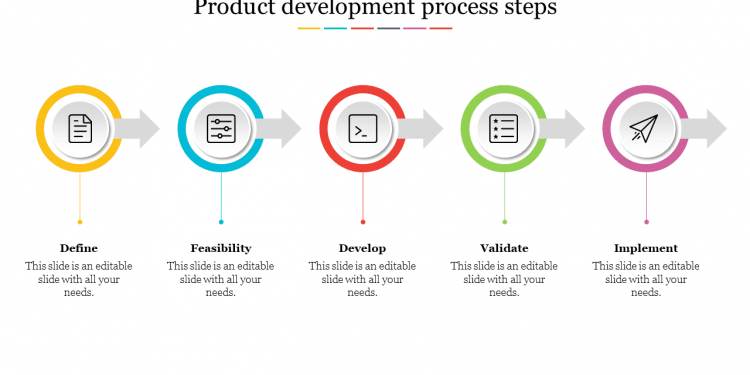When you read or hear the stories about the origin of the greatest e-commerce businesses, it often has no information about how tough that journey was. Creating a finished and successful product is a long and risky process. These motivational tale stories don’t offer a step-by-step guide to product creation, but the parallels they share highlight some of the regular actions entrepreneurs take to launch a company and deliver a finished product to a market.
Market research and product management are just a few of the numerous requirements that a proper Software product development services can provide. In our article, we’ll cover all the main and necessary points about the product development process.
What is Product Design & Development?
The entire process of bringing a product to market is known as product development. It also includes bringing an old product to a new market and updating an already existing product. This entails determining the demands of the market, envisioning the product, creating the product roadmap, releasing the product, and gathering customer feedback.
The main task of product development is not limited to one position. It connects every division of a certain company, from start-ups to large corporations, including UI/UX design, engineering, manufacturing, marketing, etc. In the process of creating, designing, testing, and launching the product, each group contributes significantly.
The New-Product-Development Process in 7 steps
The process of bringing a brand-new product concept to market is known as new product development (NPD). Despite the fact that the product development process varies depending on the sector, it may fundamentally be divided into seven stages:
1. Idea generation
Many ambitious business owners get stuck in that phase, as having a successful idea is the key and sometimes the hardest part of the development process. This frequently occurs because they are hoping for a flash of inspiration that would identify the ideal product they should offer. Although creating something genuinely “new” might be artistically gratifying, many of the finest ideas come from improving upon products that have previously been released into the market.
If you’re still thinking about such an idea, you should start by looking at product descriptions and online marketplaces, as well as historical patterns, for more ideas. It might be beneficial to use business analysis insights to have a deeper understanding of the market potential.
2. Market Research
Creating that type of a product that people will definitely pay for is ensured by-product validation, which also prevents you from wasting your time, money, and effort on a concept that you won’t be able to market. You may verify your product ideas in a variety of methods, such as:
- discussing your concept with the target audience;
- sending out online surveys to get feedback;
- starting fundraising;
- utilizing Google Trends to investigate market demand.
Note, that if your concept or market segment has the potential to gain market share, you should start analyzing existing competitors. You may learn how your rivals generate leads and close deals by visiting their websites and joining their email lists. Don’t overlook research because it’s important to the creation of new products!
3. Planning
It’s crucial to prepare ahead before starting to create your prototype since product development may soon become difficult. A detailed product plan may frequently be beneficial at this point.
The simplest way to begin conceptualizing is with a hand-drawn mockup of your final product. The drawing should include labels that describe each feature and function in as much detail as feasible. Make a list of the many parts or supplies you will require to bring the product to life using your diagram. The list doesn’t have to include every possible component, but it should help you start thinking about what you’ll need to make the product.
Don`t forget to think about the pricing! Will the item be used frequently or only on exceptional occasions? Will it be made of high-quality materials or green products? All of these queries should be taken into account throughout the planning stage as they will come in handy during the marketing stage.
4. Prototyping
Producing a finished product to serve as a sample for mass manufacturing is the aim of the prototype phase. You will rarely create your finalized product in a single effort; instead, prototyping often entails testing out numerous iterations of your product, gradually removing alternatives, and making adjustments until you are happy with a final prototype.
At this point, you should also begin testing a minimal viable product (MVP). The MVP is a prototype of your product that has just enough features for beta users to utilize. Early on in the product development phase, it aids in validating a product concept. Additionally, it enables product managers to iterate and make tiny, gradual adjustments to the product by allowing them to get customer input as quickly as feasible.
Startups make the MVP available to their first clients before conducting tests to determine customer interest, test messaging and pricing sensitivity, and more. It starts the feedback procedure by presenting concepts and recommendations based on client requirements. By doing this, you can improve the product and make it more valuable for the market.
5. Sourcing
Once you’re happy with your product prototype, it’s time to start collecting the supplies and finding the companions for production. The suppliers, tasks, and assets required to make a product and deliver it to a consumer are referred to as constructing your supply chain. Project management is essential at this point in the product development process. Finding manufacturers or suppliers will take up a significant portion of this stage, but you may also consider warehousing, shipping, and storage while making your decision.
You will undoubtedly have to choose whether to create your product domestically or abroad during the sourcing process. Comparing the two possibilities is a good idea because each one has its own benefits and drawbacks.
6. Costing
You ought to have a better idea of how much it will cost to make your product after you’ve finished your planning, prototyping, and sourcing. During the costing process, which is a step in the business analysis process, you total up your cost of goods sold (COGS) to arrive at a sale price and a margin.
Make a spreadsheet at first with each extra expense listed as a distinct line item. All of your raw supplies, factory setup charges, production costs, and shipping expenses should be included in this. In order to get your finished product into the hands of the client, you will need to pay shipping, import fees, and other tariffs. Depending on where you are creating the product, these prices might have a considerable influence on your COGS.
You may develop a price plan for your goods after calculating your total COGS.
7. Commercialization
The marketing of your product is the last phase in this process. A product development team will then turn the initiative over to marketing. By utilizing the following strategies, you can still conduct a successful go-to-market strategy:
- Emailing your subscribers about a new product;
- working on an affiliate marketing strategy with influencers;
- Make Instagram shopping possible;
- Create campaigns for chat marketing;
- Get feedback from the first clients.
Product Development Examples
Let’s take a quick look at what you would need to take into account across three of the biggest and most well-established sectors. The product development cycle will inevitably vary by industry:
-
Fashion
Product creation in the fashion sector typically starts with a hand-drawn sketch or its digital counterpart.
A pattern maker or seamstress will then turn a sketch into a sample. A size set, or a variety of samples with various measurements for each size you wish to sell, is developed during the prototype process. Production starts as soon as the size set is decided upon.
-
Beauty and cosmetics
Due to trends in health and self-care, the beauty and cosmetics sector offers a broad variety of items that are continually increasing. Many beauty firms are emphasizing all-natural ingredients and environmentalism in everything from skincare to bath products to cosmetics, which makes it simpler to create your own product prototypes with commonplace items.
Additionally common in the cosmetics and beauty sector is white labeling. Finding an existing manufacturer or product, then packaging and rebranding the goods they currently make, is the procedure. Regardless of the path you choose, mass-producing cosmetics typically involves working with scientists to maintain quality at scale.
Conclusion
Every path to a final product during product development is diverse, and each sector has its own set of challenges while innovating. If you’re having trouble making sense of it all, keep in mind that every product that came before yours had to face the same difficulties.
You may divide the daunting effort of bringing a new product to market into more manageable phases by using these steps as you go through your own product development process. Whatever you’re doing, you can set yourself up for a good result by investing the appropriate time and effort in research, planning, prototyping, sourcing, and costing.
Follow Techdee for more!





